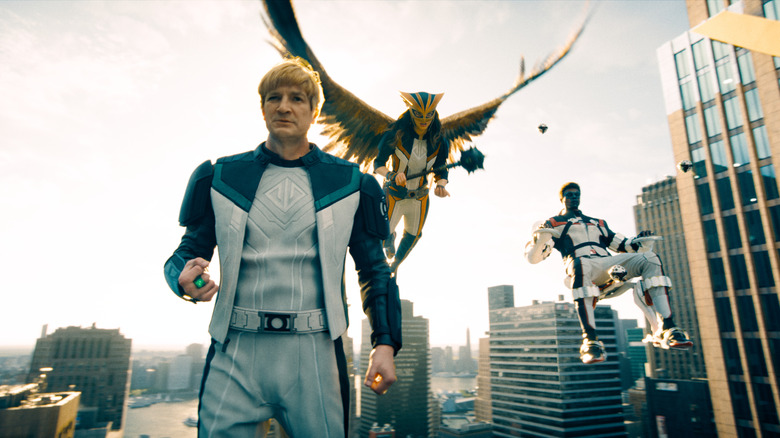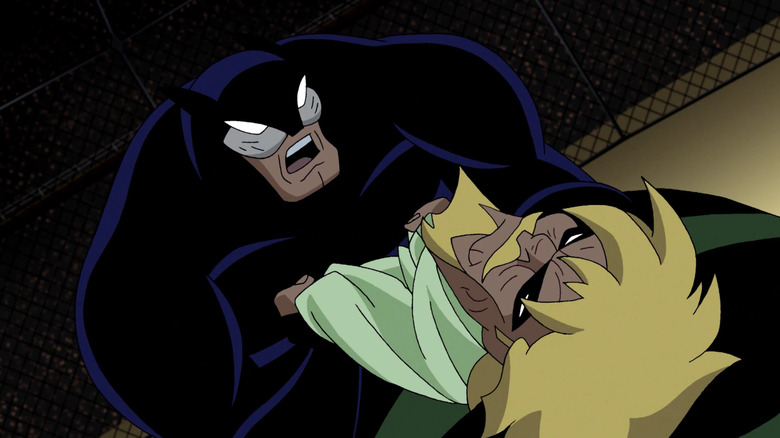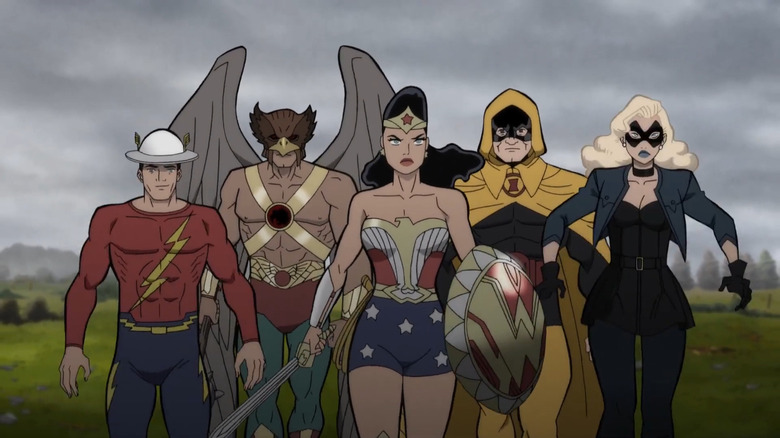James Gunn's Superman Sneaks In A Nod To The First Ever Superhero Team
James Gunn's "Superman" is a movie that builds on what's come before to stand out on its own. David Corenswet's central character is earnest, sincere, silly, and above all else, good. After 15 years of gritty, edgy DC superhero movies, having Superman go out of his way to save a squirrel in the middle of a kaiju fight feels like the final nail in the coffin of cynical and edgy superhero movies.
Arguably the biggest achievement of "Superman" is how it doesn't just feel like the start of the DC Universe, but rather like a middle chapter in a vast story that started long before the opening crawl, and goes on far beyond what we see on screen. James Gunn has created a movie that truly feels like part of a large universe that can support stories of all kinds of tones and styles — like a Clayface horror movie and a Booster Gold TV series.
If we are to take not just the many cameos but also the Easter eggs in the movie at face value, this is a universe that already had a superhero team long before the Justice Gang (name is not final) came to be. That's right, James Gunn included a nod to the very first superhero team in comic book history: the Justice Society of America.
A long history of metahumans
The Easter egg comes when we first enter the headquarters of the Justice Gang, which is a familiar sight for fans of DC's comics and animated series. James Gunn shot on location at the Cincinnati Union Terminal, which is the basis for the headquarters of the Justice League in the 1970s Hanna-Barbera "Super Friends" cartoon. Since then, the locale's iconic look has followed the Justice League throughout comics and shows, up to and including "Young Justice" and the Arrowverse.
Inside the Hall of Justice we get a blink-and-you-miss-it look at a mural, which builds on the opening text crawl of the movie and the 300-year history of metahumans on Earth. Most prominent and recognizable is the heavyweight boxer Wildcat, a hero who has appeared in shows like "Arrow" and "Stargirl." We also see what looks like Spectre, Sandman, and even Jay Garrick's original Flash. These characters are all members of the Justice Society of America, known as the world's first superhero team, debuting back in 1940 in "All-Star Comics." The Justice Society, of course, made its live-action big screen debut in the ill-fated "Black Adam."
Other heroes who can be seen on the mural include Silent Knight (a medieval hero with no superpowers), Black Pirate (who has the powers of a literal ghost) and even the armored sci-fi hero, Atomic Knight.
An exciting future for DC
Though this could just be an Easter egg, the inclusion of Justice Society characters in "Superman" is very significant. It doesn't matter if James Gunn does something with this in the next year or 15 years from now when the DC Universe is running out of ideas, but it's the mere fact that this is now a universe where heroes have been around for centuries and where there already has been at least one superhero team is quite a big deal.
And it is all part of the world-building of the movie. As Gunn told BuzzFeed, the mural came about as a need to replace a real historical mural at the Hall of Justice location with "a mural of the metahumans that have existed in the DCU over the years." So, yes, he's confirmed all these heroes have been active at one point or another in the time before "Superman."
This can give the DC Universe something Marvel has never quite figured out: legacy. Though the Marvel Cinematic Universe toyed with that idea, mostly in the "Hawkeye" series, it has yet to really explore the ramifications of superheroes passing the baton to the next generation, or how heroes acted in previous eras. DC, on the other hand, has this in spades, most prominently in the animated show "Young Justice," which excels at showing mentors passing their mantle to their proteges and hero titles having several generations (like Aquaman). The Arrowverse series "The Flash" did this as well, with Jay Garrick becoming a mentor to Barry Allen.
If the DC Universe leans into this idea of superheroes being around for centuries, it helps sell a fleshed-out and lived-in universe. And if James Gunn and Peter Safran intend on keeping this franchise alive for more than a decade, having heroes like Batman, Aquaman, or even Superman (down the line) pass on the torch to proteges or their kids would be quite a cool idea straight from the comics. What better way to start showing that legacy than by connecting the future Justice League (or even the current Justice Gang) to the original team of heroes?


